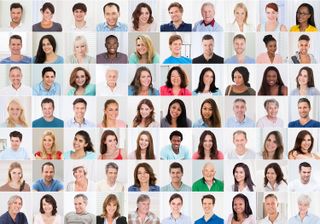Your Memory Could Store Up to 10,000 Faces, or More

How many faces do you retain in your memory?
If you add up your immediate and extended family, schoolmates, friends, co-workers, and celebrities that you know through movies, television and the internet, you might easily be able to list a few hundred faces that you'd recognize on sight. But the real number of faces stored in your brain may be much higher than that.
For the first time, researchers have pinned down the number of faces that people remember; the findings come from a small study of 25 people ages 18 to 61 years old. The answer: 5,000 on average and up to 10,000. [The 10 Greatest Mysteries of the Mind]
The scientists tested participants' ability to recognize the faces of people the subjects knew personally and the faces of famous people, finding that the participants could identify 5,000 faces on average as being "familiar" to them.
In the study, the participants were asked to make lists of people from their lives whose faces they could picture or whom they would easily recognize if they saw them in person. The scientists also asked the subjects to identify celebrities from thousands of photos.
Participants were not required to attach names to the faces they said they knew, as "naming is clearly separable from visual recognition," the scientists explained.
From the study's findings, it's clear that facial-recognition ability varies widely between individuals; some people could remember as few as 1,000 faces and some as many as 10,000, and some people clearly have a tougher time than others recognizing faces. Anecdotal evidence outside of the study underscores this. For example, the actor Brad Pitt gave an interview in 2013 about having difficulty remembering people that he'd met before, mentioning that he "can't grasp a face."
Sign up for the Live Science daily newsletter now
Get the world’s most fascinating discoveries delivered straight to your inbox.
A condition called prosopagnosia, also known as face blindness, impedes facial recognition and may affect millions of people, Live Science previously reported. (This does not necessarily include Pitt, who has not been diagnosed with the disorder.)
Studies have also shown that the mechanisms that allow people to recognize faces can vary between cultures, and face blindness tends to be higher when people are looking at faces of another race, according to Scientific American.
Future research could investigate whether age plays a part in facial-recall capacity or in the number of faces that we recognize, study co-author Rob Jenkins, a psychologist and cognitive scientist with the Department of Psychology at the University of York in the United Kingdom, said in a statement.
"It would be interesting to see whether there is a peak age for the number of faces we know," Jenkins said. "Perhaps we accumulate faces throughout our lifetimes, or perhaps we start to forget some after we reach a certain age."
It's also likely that the highest number from the study — 10,000 faces — is far from the upper limit of human facial memory, Jenkins added.
"We haven’t yet found a limit on how many faces the brain can handle," he said.
The findings were published online Oct. 10 in the journal Proceedings of the Royal Society B: Biological Sciences.
Originally published on Live Science.

Mindy Weisberger is an editor at Scholastic and a former Live Science channel editor and senior writer. She has reported on general science, covering climate change, paleontology, biology, and space. Mindy studied film at Columbia University; prior to Live Science she produced, wrote and directed media for the American Museum of Natural History in New York City. Her videos about dinosaurs, astrophysics, biodiversity and evolution appear in museums and science centers worldwide, earning awards such as the CINE Golden Eagle and the Communicator Award of Excellence. Her writing has also appeared in Scientific American, The Washington Post and How It Works Magazine.
Most Popular


